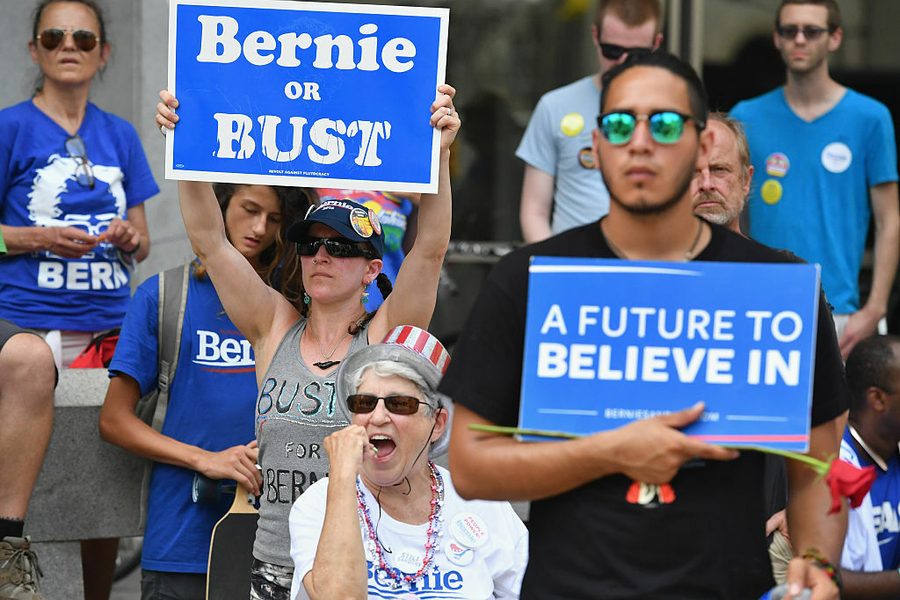Bernie-or-Bust Is Real and Probably Not Going Away Anytime Soon
The DNC is shaking up to be a wild experiment in democracy.
Kate Aronoff

PHILADELPHIA — Bernie-or-Bust is bigger than anyone bargained for. And neither Hillary Clinton nor Bernie Sanders has yet figured out a way to make it smaller.
The ardent support for Sanders — against Clinton — has taken just about everyone at the Democratic National Convention off guard. For months it’s been easy enough, especially on the left, to pass off Bernie-or-Bust as a trumped-up fabrication by discontented Clinton voters and a mainstream media out to bolster the establishment.
But the anger and disillusionment at the convention are real. As is the promise, from some, to not vote for Clinton come November.
I met Gabriel McArthur, a Sanders delegate from North Denver, shortly after he’d finished chanting outside Sanders’ speech to his delegates Monday afternoon. McArthur, 24, ran in his Congressional district to become a delegate after finding Sanders on an isidewith.com quiz.
He sees virtually “no hope” in Sanders’ chances at winning the nomination, adding: “It’s not going to keep me from talking to people about it.” His top criteria in choosing candidates is whether they stand by their values.
“He’s consistent,” McArthur said about Sanders.
He says he won’t vote for Clinton, and is mulling over the possibility of supporting Green Party candidate Jill Stein.
McArthur isn’t alone. Between Sanders getting shouted down by his own delegates, to a nascent attempt by post-Occupy groups to walk out on the DNC, and the BER-NIE chants and boos that rung through the convention center during Monday’s speeches, it seems there are many, many thousands of people with no intention of voting for Clinton.
Nor do those people seem willing to take to heart comedian Sarah Silverman’s admonishment at the convention: “To the ‘Bernie or Bust’ people, you’re being ridiculous.”
Of course, what can be gleaned from the Democratic National Convention is a sample size, at best. Thirteen million people voted for Sanders. According to a recent Pew Research Center poll, 90 percent of them say they will back Clinton in November. Still, more than a million defectors are hard to ignore — especially with the possibility of Donald Trump taking over the White House.
“A substantial number of Bernie delegates are so loyal to him and so unhappy that they’re not hearing him,” says Dan Cantor. “Right now there’s a lot of anger … A substantial chunk of Sanders delegates are not yet thinking strategically and seriously about the stakes here.”
Cantor — the national director of the Working Families Party, which voted to endorse Sanders back in December — sees room for improvement on both Sanders’ and Clinton’s parts.
“Sanders needs to make the case to his own base,” Cantor said yesterday, “that the political revolution he wants to continue will have a much better chance to flower with Clinton in the White House, no matter how imperfect her administration will be.”
Clinton, Cantor advised, “needs to elevate issues like the Fight for $15, like college affordability, like racial justice and fighting climate change and investment in job creation — places where she has moved toward Sanders. She has to give people a reason to believe that, at least in part, she is carrying forward Sanders’ mission.”
Clinton has been treating the race as over since she won California in the primaries, pivoting — as we saw last night — to making a show of Trump’s vulgarity and allergy to the politically correct: death to neo-fascism by a thousand fact checks. Sanders’ speech to his delegates yesterday afternoon — what could have been his chance to make a difficult, honest speech about his commitment to defeating Trump — repeated the same tirades against the millionaires and billionaires he’s made throughout his campaign. His pitch for Clinton was an afterthought and went over just about as well as it could have to a crowd that for months has seen Clinton as public enemy No. 1.
For many Sanders supporters — delegates included — his campaign was their entry into politics writ large, along with the Democratic Party. That some tied their hopes to a revolution by November isn’t entirely surprising, and neither is their disappointment that the party couldn’t deliver. Speaking at the convention last night, Sanders stressed the political revolution, “Our Revolution,” as he calls it, would carry on.
“This election is not about, and has never been about, Hillary Clinton, or Donald Trump, or Bernie Sanders or any of the other candidates who sought the presidency,” he said. “Election days come and go but the struggle of the people to create a government that represents all of us and not just the one percent … that struggle continues. And I look forward to being part of that struggle with you.”
Although his speeches Monday likely won’t convince every Bernie-or-Bust supporter, Sanders tried to give his fans a framework for understanding what comes next — not Bernie in the White House, but the slower and less glamorous work of building a movement outside the spotlight of a presidential race.
After all, steering the Democratic Party’s angry Bernie-or-Bust base away from apathy, nihilism and hopeless Green Party fights — indeed, fighting the threat Trump poses to the country’s most vulnerable communities — has never been up to politicians. In this election, it’ll be up to the millions of donors, hundreds of thousands of volunteers and social movements that brought Sanders to Philadelphia in the first place.
In contrast to the Republican National Convention’s eerie singularity, the DNC has been a messy democratic experiment conducted by a slew of actors, most of whom aren’t used to having a man on the inside. Not everyone is thinking strategically, though many are; some are thinking dangerously. As Sanders takes a backseat in the political revolution, the question now is who can keep it from driving off a cliff.
Kate Aronoff is a staff writer at The New Republic and author of Overheated: How Capitalism Broke the Planet — And How We Fight Back. She is co-author of A Planet To Win: Why We Need a Green New Deal and co-editor of We Own the Future: Democratic Socialism—American Style. Follow her on Twitter @katearonoff.








